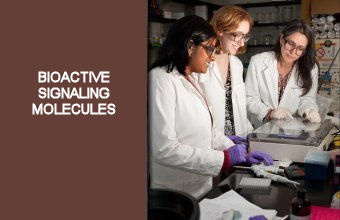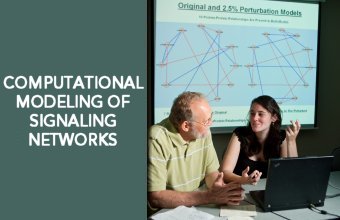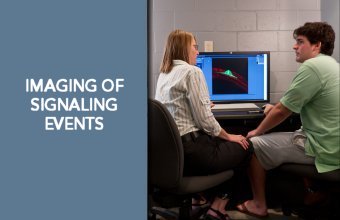Emphasis Areas
The understanding of how signaling pathways cooperate to alter the activity of cells and organisms is a common intellectual interest shared by WFU research laboratories using numerous organisms and diverse but complementary disciplinary approaches. The research activities that are the foundation of the CMCS are clustered into four groups that utilize different interdisciplinary approaches to study cell signaling and communication. The strength of faculty interest in collaborative research is reflected by faculty participation in multiple groups, a pattern resulting from commitment to intellectual growth through multidisciplinary teams using new approaches to answer research questions.
Emphasis 1: Chemical Biology of Signaling
Researchers in this group use chemical biology (utilizing synthetic probes to discover modification sites in cells) and structural biology (analyzing protein conformation and dynamics) to detect “when and where” particular regulatory modifications take place in proteins and cells, and how the shapes and flexibility of proteins work together to send messages within the cell.

Participants: Alexander, Comstock, Cramer, Daniel, Furdui, Godwin, Hollis, Johnson, King, Kim-Shapiro, Loeser, Lowther, McPhail, Poole, Salsbury, Torti, Xue
Emphasis 2: Computational Modeling of Molecular Communication
This group brings together biologists who generate original data sets and computer scientists and mathematicians who build models to find patterns and relationships in these data sets. Investigators focus on the computational modeling of networks of molecules that facilitate communication within and between cells.

Participants: Allen, Fetrow, Hiltbold, John, Loeser, Muday, Norris, Poole, Turkett
Emphasis 3: Imaging of Signaling Events
This group has coalesced around a common need for microscopic imaging tools to study molecular communication events including recognition of environmental cues, response by activating intracellular mechanisms, and communication of this information to nearby and/or distant cells.

Participants: Antinozzi, C. Browne, Fahrbach, Guthold, Johnson, King, Macosko, McCauley, Muday, Pratt, Poole, Scarpinato, Silver
Emphasis 4: Redox Biology in Molecular Signaling
These researchers share a common interest in investigating and discovering new ways in which oxidation and reduction (redox) chemistry transforms biomolecules, regulating their function within signaling and metabolic pathways. In particular, while oxidative damage has long been understood to contribute to aging and pathological processes (e.g. cancer, neurodegenerative diseases and diabetes), the realization that redox modifications of signaling proteins are widespread and necessary for proper cell function. Proper cell function is a relatively recent insight, contributed to significantly by members of this group.

Participants: Alexander, Chen, Daniel, Deora, Furdui, Hollis, Howlett, Kim-Shapiro, King, Lowther, McCall, Molina, Muday, Nelson, Parks, Petrovic, Poole, Tsang, Newman, Wommack
